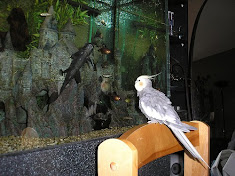 |
| Hamster's First Birthday by Dan Derrett |
Luckily, they now make tubular habitats that are built smaller and specifically for mice. Dwarf hamsters do better in these types of enclosures. They will also do well in a 10-20 gallon tank or a wire cage. Hamsters are naturally active creatures. So a wheel that can be placed inside the cage and can be used to run on is extremely important. Some research has indicated that hamsters can run up to five miles on their wheel. There are smaller wheels specifically made for dwarf hamsters.
A substrate on the bottom of your dwarf hamster's cage will satisfy their natural burrowing instincts. Owners need to use a dust free and absorbent material like wood shavings but not cedar or pine based products due to the repertory problems these materials can cause. The substrate in the hamster's cage should be completely emptied out and replaced every week. Hamsters like to make nests out of the substrates in their cages. Owners can also offer their hamsters a number of other nesting materials like paper towels, cotton, shredded paper, or tissues. Their next will often be constructed in small places, kind of like a nesting box. Because they are naturally shy animals, they like the privacy that these boxes offer.
Because of their high metabolism, dwarf hamsters eat as much as the larger Syrian hamster. They eat different types of pellets, seeds, dried fruits and vegetables. Although hamsters tend to hoard their food in their nests rather then leaving it in their bowls, they still need to be offered a constant supply of fresh foods and a fresh water supply. Another important aspect that owners need to be concerned about is ensuring that their hamsters receive chewing toys. Dwarf hamsters have a high metabolism making them each as much as the larger Syrian hamster. Without soft wooden toys to keep them busy they are liable to chew on plastic accessories which could injure them if chewed to become rough and broken.
In addition to replacing the substrate of the hamster's cage on a weekly basis, the cage and all of its accessories need to be washed weekly. Owners can use a light solution of soap and water and make sure to rinse everything thoroughly. The cage should also be completely dry before new substrate is added to the cage. Never use harsh chemicals because this can irritate hamsters. Although they require a moderate amount of care, the joy of owning a dwarf hamster far out weigh the amount of effort that needs to be put into the care of these amazing creatures.
Author Resource: Mary Wilbur is a Dwarf Hamster expert. For more great information on Dwarf Hamster Pet for Kids, visit http://www.dwarfhamsterscare.com
Article From Pet Article World



0 comments:
Post a Comment